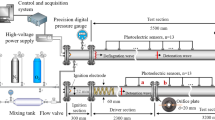Abstract
While extensive studies have been conducted concerning the formation of detonation waves in various combustible gaseous mixtures under static conditions since the 1950s, there is very little experimental work on simple flowing systems. In this study, experiments on the deflagration to detonation transition (DDT) of a hydrogen–air flow system were carried out to see the effects of tube diameter, equivalence ratio, and flow types in a premixed and non-premixed flow. Tube diameters used were 25, 50, and 100 mm. The premixed experiments show that the larger tube diameter provides a wider range in run-up distance, reduction of L DDT/D (ratio of the run-up distance, L DDT to tube diameter), and expansion of the detonable concentration limit by spreading the cell width. The result of the non-premixed experiments show that similar values of the run-up distance to the premixed experiments are obtained at an equivalence ratio of about 1.0, however, fluctuations of DDT occur near the DDT concentration limit. Under laminar flow conditions at a Reynolds number of less than 2,300, the difference between the two systems could not be observed. However, when the Reynolds number increases towards turbulent conditions, the DDT run-up distance decreases compared to that of static flow conditions.
Similar content being viewed by others
References
Laffitte P., Dumanois P.: Influence of pressure on the formation of the explosive wave. Compt. Rend. Acad. Sci. Paris 183, 284 (1926)
Laffitte P.: Influence of temperature on the formation of explosive waves. Compt. Rend. Acad. Sci. Paris 186, 951 (1928)
Egerton A., Gates S.F.: On detonation in gaseous mixtures at high initial pressures and temperatures. Proc. R. Soc. Lond. Ser. A 114, 152 (1927)
Egerton A., Gates S.F.: Further experiments on explosions in gaseous mixtures of acytelene, of hydrogen and of pentane. Proc. R. Soc. Lond. Ser. A 116, 516 (1927)
Shchelkin K.I., Sokolik A.S.: The effect of chemical presentation on the initiation of the detonation wave. Soviet. Zhurn. Phys. Chem. 10, 479 (1937a)
Shchelkin, K.I., Sokolik, A.S.: Acta Physicochim URSS 7, 589–596 (1937b)
Campbell, G.A., Rutledge, P.V.: Detonation of hydrogen peroxide vapour. Inst. Chem. Eng. Symp. Ser. 33, p. 37. Institute of Chemical Engineering, London (1972)
Bollinger L.E., Fong M.C., Edse R.: Experimental measurements and theoretical analysis of detonation induction distance. Am. Rocket Soc. J. 31, 588 (1961)
Bollinger L.E., Laughrey J.A., Edse R.: Experimental detonation velocities and induction distances in hydrogen–nitrous oxide mixture. Am. Rocket Soc. J. 32, 81 (1962)
Urtiew P., Oppenheim A.K.: Experimental observations of the transition to detonation in an explosive gas. Proc. R. Soc. Lond. Ser. A 295, 13–28 (1966)
Guirao, C.M., Knystautas, R., Lee, J.H.: A summary of hydrogen–air detonation experiments. NUREG/CR-4961, SAND87–7128 (1989)
Lee, J.H., Knystautas, R., Chan, C.K.: Turbulent flame propagation in obstacle-filled tubes. In: Proceedings of the 20th Symposium (International) on Combustion, pp. 1663–1672. The Combustion Institute, Pittsburgh (1984)
Peraldi, O., Knystautas, R., Lee, J.H.: Criteria for transition to detonation in tubes. In: Proceedings of the 21st Symposium (International) on Combustion, pp. 1629–1637. The Combustion Institute, Pittsburgh (1986)
Dorofeev S.B., Kuznetsov M.S., Alekseev V.I., Efimenko A.A., Breitung W.: Evaluation of limits for effective flame acceleration in hydrogen mixtures. J. Loss Prev. Process. Ind. 14, 583–589 (2001)
Knystautas, R., Lee, J.H.S., Moen, I.O., Wagner, H.G.: Direct initiation of spherical detonation by a hot turbulent gas jet. In: Proceedings of 17th Syrup. (International) on Combustion, pp. 1235. The Combustion Institute, Pittsburgh (1979)
Bollinger, L.E., Smith, G.C., Tomazic, F.J., Edse, R.: Formation of detonation waves in flowing hydrogen-oxygen and methaneoxygen mixtures. AIAA J. 4, 1773–1776 (1966)
Farinaccio, R., Harris, P.G., Stowe, R.A.: Turbulent flow effects on DDT run-up distance for a pulse detonation engine. In: 40th AIAA/ASME/SAE/ASEE Joint Propulsion Conference and Exhibit, Fort Lauderdale, Florida, July 11–14, 2004, AIAA Paper, pp. 2004–3917 (2004)
Kaneshige, M., Shepherd, J.E.: Detonation Database. GALCIT Report FM97-8, 170 pp, July (1997)
Tanaka, T., Ishii, K., Tsuboi, T.: A study on shortening of a detonation transition distance. In: Proceedings of the Thirty-ninth Symposium (Japanese) on Combustion. pp. 461–462 (2001)
Tanaka, T., Ishii, K., Tsuboi, T.: A study on shortening of a detonation transition distance. In: Proceedings of the Thirty-ninth Symposium (Japanese) on Combustion. pp. 461–462 (2001)
Li J., Lai W.H., Chung K.: Tube diameter effect on deflagration-to-detonation transition of propane-oxygen mixtures. Shock Waves 16, 109–117 (2006)
Enskog, D.: Archiv för Matematik, Astronomi, och Fysik, 16, §16 (1922)
Hirschfelder, J.O., Curtiss, C.F., Bird, R.B.: Molecular Theory of Gases and Liquids. pp. 466 Wiley, London (1964)
Kuznetsov, M., Alekseev, V., Matsukov, I., Dorofeev, S.: DDT in a smooth tube filled with a hydrogen–oxygen mixture. Shock Waves 14(3), 205–215 (2005)
Author information
Authors and Affiliations
Corresponding authors
Additional information
Communicated by S. Dorofeev.
This paper is based on work that was presented at the 21st International Colloquium on the Dynamics of Explosions and Reactive Systems, Poitiers, France, July 23–27, 2007.
Rights and permissions
About this article
Cite this article
Aizawa, K., Yoshino, S., Mogi, T. et al. Study of detonation initiation in hydrogen/air flow. Shock Waves 18, 299–305 (2008). https://doi.org/10.1007/s00193-008-0166-6
Received:
Revised:
Accepted:
Published:
Issue Date:
DOI: https://doi.org/10.1007/s00193-008-0166-6
Keywords
- Detonation
- Flow system
- Hydrogen/air mixture
- DDT run-up distance
- Reynolds number
- Premixed and non-premixed mixture




